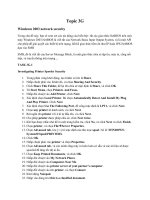Network Basics
Bạn đang xem bản rút gọn của tài liệu. Xem và tải ngay bản đầy đủ của tài liệu tại đây (155.66 KB, 14 trang )
Network Basics
Objectives
Upon completion of this module, you should be able to:
• Describe the terms client-server and distributed processing
• Open a session on a remote machine using telnet
• Log in remotely to another machine on the network
• Use ftp to get a file from a remote system
• Identify users logged in on the local network
• Describe the concept of naming services
Discussion – What network features do you use now? What do you think would be the
advantages of being connected to other users, or a central file server?
Important – This is a fundamentals class, basically aimed at end-users. This
module is
intended as an introduction to network commands only. It is strongly suggested that
you do not teach the system administration files used for networking here. That topic
is fully covered in the SA-287 course and not intended for this audience.
Be sure you have a naming service running so the students can use the rlogin
and
rusers commands.
Client-Server
Example Networking Environment
Figure 17-1 shows a sample networking environment with workstations, a printer,
and so on.
Figure 17-1 Example Linux Networking Environment
You may want to explain to the students the difference between having access to a
naming service and not having access to a naming service. You cannot assume that
students will have access when they go back to their working environment.
If you are not running a naming service, the host name and IP address must be
recognized by the remote system as being in the /etc/hosts file.
If the user does not have a home directory on the remote machine, the user is
automatically placed in the root (/ ) directory.
Distributed Processing
Distributed processing enables access to remote systems for the purpose of sharing
information and network resources. It also enables communication with users on
other systems.
Network
A network is a connection that enables an exchange of information between machines.
Two types of networks are:
• Local area network (LAN) – A network that covers a small area, usually less
than a few thousand feet.
• Wide area network (WAN) – A network that can span thousands of miles.
Host
A host is a computer system on a network. The local host is the machine on which the
user is currently working. A remote host is a system that is being accessed by a user
from another system.
Server
A server provides resources to one or more clients by means of a network.
Client
A client is a machine that uses the services from one or more servers on a network.
Naming Services
Sometimes it is useful to have a common user and group list for hosts on a network.
In such situations, a naming service can be implemented by the sytem administrator.
A naming service allows users to be recognized by all remote machines on the
network. If the system administrator on your network chooses not to use a naming
service, you must have an account on a remote machine in order to log in to it.
Network Commands
telnet
telnet is an application that is part of the Linux environment. It utilizes
Transmission Control Protocol/Internet Protocol (TCP/IP) to connect to another
system.
The telnet server simulates a terminal in order to authorize a user to connect
to a remote system and work in that environment. When using telnet, you can:
• Open a session on a remote machine
• Alternate between the remote session and the local session
• Access machines that do not run under the UNIX environment
The following is an example of using telnet to connect to a remote system
called beach:
$ telnet beach
Trying 192.9.49.10 ...
Connected to beach
Escape character is ‘^]’.
4.2 BSD UNIX (beach)
login: jdupont
Password:
Last login: Wed Jun 1 19:03:33 on console
beach% (Enter commands)
beach% exit
Connection closed by foreign host
$
The following is an example of using telnet to alternate between the remote
session and a local session:
$ telnet beach
Trying 192.9.49.10 ...
Connected to beach
Escape character is ‘^]’.
4.2 BSD UNIX (beach)
login: jdupont
Password:
Last login: Wed Jun 1 19:08:15 on console
beach% ^]
telnet> !
$ pwd
/home/user2
$ exit
beach% exit
Connection closed by foreign host
Using the rlogin Command
Overview
Use the rlogin command to establish a remote login session on another
workstation.
Remotely logging in to a workstation is helpful under the following
circumstances:
• To access information on another workstation that is not available
otherwise
• To access your workstation remotely to read mail.
• To kill a process that has caused your workstation to hang
Command Format
rlogin hostname [-option]
Remotely Logging in to Another Host
$ rlogin saturn
Password:
Last login: Mon Dec 21 11:04:27 from venus
Sun Microsystems Inc. SunOS 5.7 Generic October 1998
$ id
uid=102(user2) gid=10(staff)
$ uname -n
saturn
$ pwd
/home/user2
$ exit
Connection closed.
$
Specifying a Different Login ID
Use the -l option to specify a different login ID for the remote login session.
The system administrator can set up a guest account so users can remotely log on
to a server.
Command Format
rlogin hostname -l username
Before attempting to remotely log in to another system as a different user, be sure
you have an account on the desired remote machine. Check with your system
administrator if you do not have an account on the remote machine. The
information you will need to know is:
• Machine name
• Login ID
• Password of the new account









